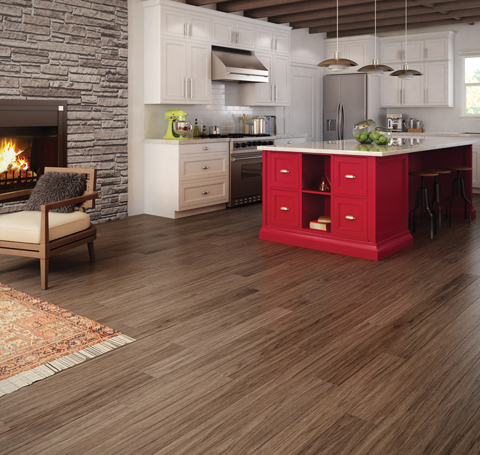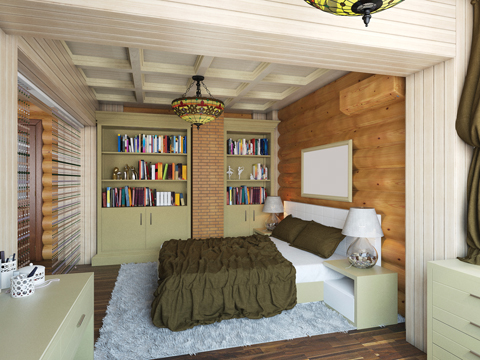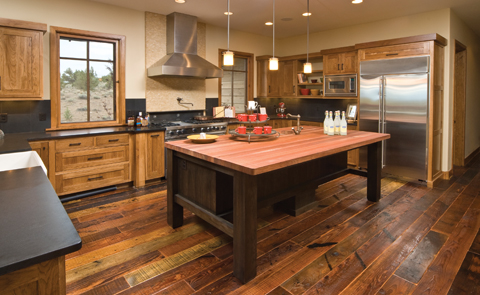Selecting flooring for your log or timber frame home is a big decision, and not just because it’s a big-budget item. Flooring makes a major impact on the overall look and feel of your home. There are more choices than ever on the flooring market, so it pays to do a little bit of research before making a final selection. It also makes sense to rely on the expertise of your log home builder and interior designer, who have experience with different materials and can steer you in the right direction.
Considerations Under Foot
Yes, that travertine marble is exquisite—but before you fall head over heels in love and commit to it (or any other flooring choice) you’ll want to keep a few things in mind: Lifestyle. If your home is often a flurry of activity, with kids and pets running in and out, you will want to select a material that is durable and can easily be repaired or refinished. On the other hand, if your lifestyle will lead to less wear and tear, you can be comfortable choosing a slightly more delicate flooring material.
Design. “The first step is to identify the mood you want in your home—one might be cozy while another is contemporary,” says Kathryn Long, ASID, of Ambiance Interiors in Asheville, North Carolina. Make sure the flooring you choose is compatible with the overall feel of your home. If you are building a cozy cabin, sleek tile might look out of place. At the same time, it’s okay to push the boundaries a little bit. A blend of rustic and contemporary can be beautiful—perhaps reclaimed hardwoods anchoring an otherwise modern home.

Concrete flooring can be dyed, scored, or stamped to match your style. Photo by Heidi Long
Comfort. Keep your physical comfort in mind when considering different flooring options. That natural stone may look stunning in the kitchen, but if you plan to spend hours on your feet cooking, you might want a more forgiving material like wood or cork. Your back will thank you! Many people love the idea of plush carpeting in the bedroom, but those with allergies will want to avoid carpets and rugs that may harbor pet dander, dust mites, mildew, and mold.
Materials
Hardwoods. Solid and engineered hardwoods are both natural choices for a log or timber frame home, available in a spectrum of hues and finishes. For a more rustic look, choose wide planks (4-8”) with character; if you’re going for elegance, 1.5-2.5” strips with less grain are a better choice.
Durability will vary by species—oak and maple are very hard and durable, while pine is more likely to show wear. Engineered hardwoods are made from a veneer of hardwood glued over plywood. These engineered planks are more stable and less susceptible to moisture and temperature. In general, the methods used to finish wood floors have improved considerably over the years, making hardwoods a great choice even in kitchens and baths.
Many people are using reclaimed wood for floors. “I’m seeing more people using reclaimed wood because there are more and more local suppliers, which brings the price down a little bit and improves availability,” says Long. “We are currently working with a vendor that was tearing down old textile mills and making floor out the wood. The wood is gorgeous because it already has that patina.”

Preverco’s Hickory engineered hardwood flooring is both beautiful and durable. © Preverco, Inc.
Stone. Natural stone flooring is another material that complements log and timber frame homes in almost any style. You can use honed and polished stone tiles for a luxurious contemporary look, or rougher natural stone tiles to truly bring the outdoors inside. Keep in mind that polished stone will be slick when wet, so it is probably not the best choice for bathrooms and kitchens.
Not all stone is created equal—some varieties require more care than others, though most will need to be resealed every few years to maintain moisture resistance.
Tile. Tile flooring has come a long way in recent years, with more varieties available than ever before. “On a recent project we did a porcelain tile that looked just like a quartzite stone, so it didn’t have any of the problems you can have with slate like chipping or flaking but you still get the look of stone,” says Debra Browne, ASID, of Harrison Browne Interior Design in Carbondale, Colorado. “Tile is one of the best things to do with radiant in-floor heat,” she adds.
Many designers are using square tiles as large as 36×36”, and even plank tiles. You can find tiles that look like hardwood or even cement, to replicate the appearance you want without sacrificing performance. “You don’t have to refinish the floor—these tiles are very, very durable,” says Browne. “They don’t have to be resealed like wood and natural stone do.”
Know the difference between ceramic and porcelain tiles—porcelain is denser and less likely to crack or chip, so it is often the better choice for flooring! Look for a MOHs score, which rates the hardness of tiles from 1 (softest) to 10 (hardest).

Mannington’s Beachwood porcelain tile is designed to look like reclaimed wood planks. ©2015 Mannington Mills, Inc.
Concrete. It won’t surprise you to hear that concrete floors are durable. What may surprise you is the variety of looks that can be achieved with concrete! Poured concrete is a versatile, eco-friendly choice that can be stained, dyed, scored, and even stamped to look like tile or stone.
Durable doesn’t mean care-free, however. You will have to reseal your concrete floor at regular intervals to protect from moisture and wear.
Carpet. Who doesn’t love stepping barefoot onto a soft carpet? But a fully carpeted house rarely makes sense these days. Besides being notorious for hosting allergens like dust mites and pet dander, carpet is not the best choice for high-wear, high-traffic areas of the home, where even the best quality carpet will show its age quickly.
Some areas that you might want to consider carpeting are the bedroom, or a den or library, where you want a cozy, warm feeling that hard floor surfaces just can’t replicate. Consider wool, which may be pricy but is naturally hypoallergenic. Other options include nylon and acrylics, which are stain resistant at a lower price point than wool.

If you like to step out of bed onto a cozy carpet, consider using an area rug on top of your hardwood floors. Richman21
Making a Final Pick
There are many options beyond carpet, concrete, tile, stone and wood. Cork, bamboo, linoleum, and marmoleum are other popular floor materials with new and exciting variations coming to the market all the time. Making a final pick can be daunting, so this is where a design professional can help! “
We are aware of what the newest products are—it’s our business to be up to date on all of the latest things,” says Browne, who adds that many designers will work as consultants on just parts of a project. “It is my business to really get into the clients’ head and see the world through their eyes and figure out how they want to live and enjoy their surroundings.”

